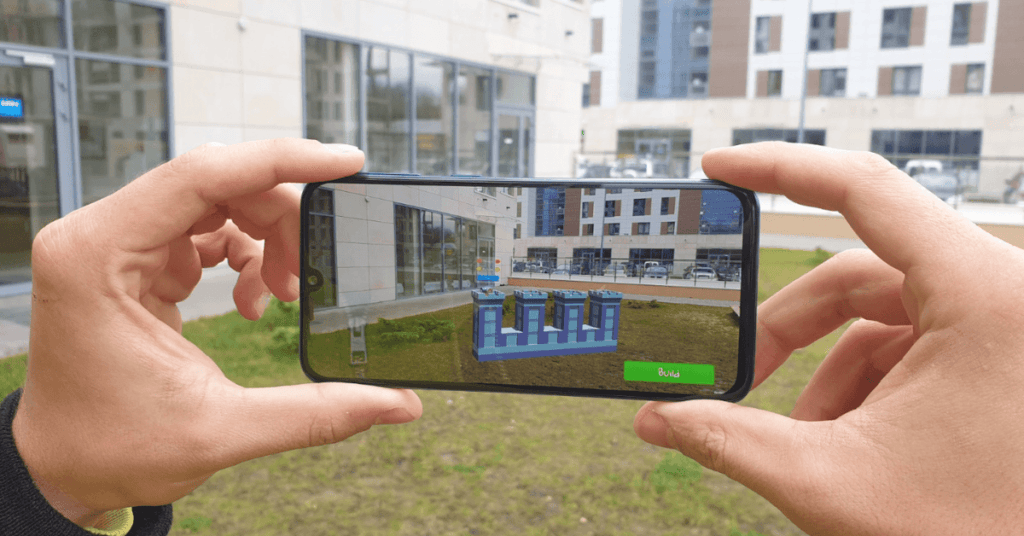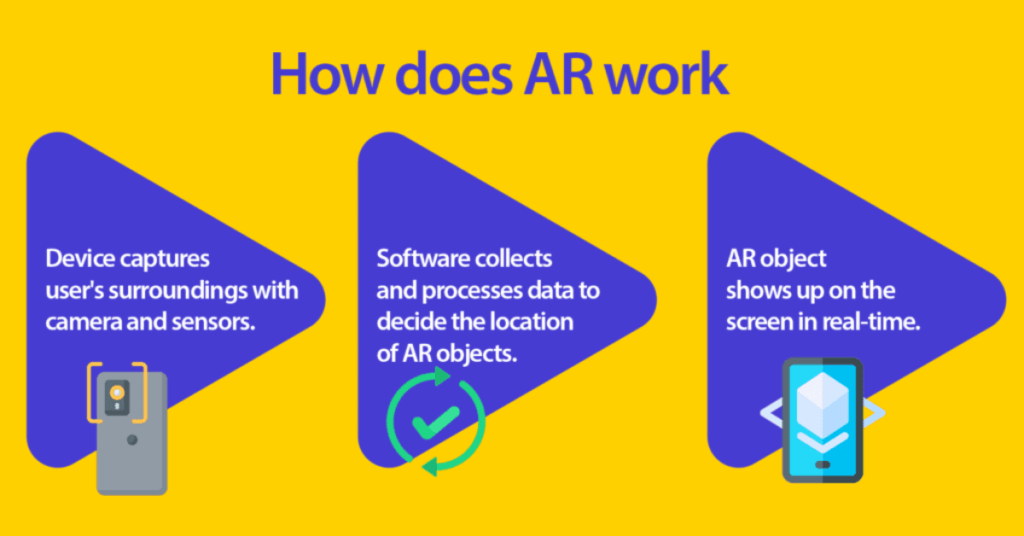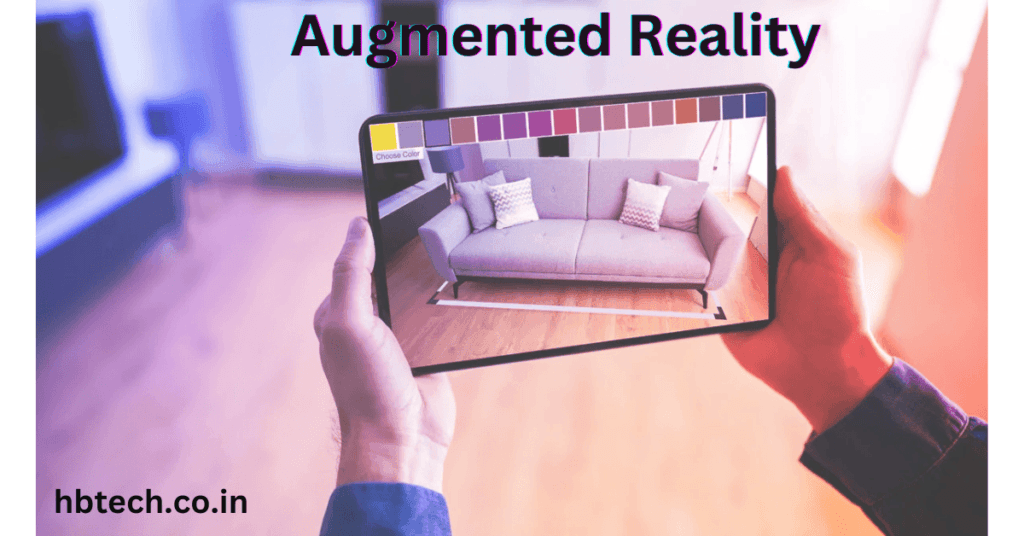Augmented Reality (AR) is one of the most exciting and innovative technologies in the world today. It ‘s changing the way we interact with both the digital and physical worlds, bringing new opportunities to various industries. Whether it’s playing games, enhancing our learning experiences, or improving work efficiency, AR is making a huge impact. In this article , we’ll explore what AR is, how it works, and the ways it’s already changing our everyday lives.
About Augmented Reality
Augmented Reality (AR) is a technology that superimposes digital content—like images , sounds, and videos—onto the real world. Unlike virtual reality (VR), which creates an entirely virtual world, AR enhances your view of the physical world by adding digital layers to it. For example , when you play AR games like Pokémon GO, virtual creatures appear to be in your real surroundings through your phone screen.

Working of AR

To bring AR experiences to life, a combination of several technologies work together;
- Devices: Smartphones, tablets, and AR glasses are commonly used to view AR content. These devices have sensors like cameras, GPS, and motion detectors, which capture the environment and help the AR system understand where to place digital elements.
- Software: AR apps use special software to interpret the data from the device. ’s sensors and overlay digital information on what you see. This software helps ensure that the digital objects are placed accurately and interact naturally with the real world.
- Interaction: AR is designed to be interactive. Users can engage with digital content using gestures, touch, or voice commands, making the experience more immersive and fun.
Everyday Uses of AR
While AR might sound like something from a science fiction movie, it’s already making waves in various fields. Let’s look at some real-world applications;
1. Education
AR is making learning more interactive and exciting. Instead of just reading about historical events or scientific concepts in textbooks, students can explore 3D models of the human body, ancient civilizations, or planets. This hands-on approach helps students understand complex subjects in a more engaging way.
2. Retail and Shopping
Shopping has become more fun and convenient with AR. For example, some furniture stores offer AR apps that let customers see how a piece of furniture would look in their homes before buying it. Similarly, makeup brands allow customers to try products virtually, helping them make better decisions without ever stepping into a store.
3. Healthcare
In healthcare, AR is improving surgeries and medical training. Surgeons can use AR to overlay detailed medical scans on patients’ bodies during procedures, allowing for greater precision. AR also helps medical students practice in realistic virtual environments, which is crucial for their training.
4. Tourism and Navigation
AR is transforming travel experiences. With AR navigation apps, you can point your phone at a street and see directions or nearby attractions displayed on your screen. Some museums also use AR to offer interactive tours. , letting visitors access more information and even view historical events in action through their phones.
5. Workplace and Collaboration
In the workplace, AR is making remote collaboration more effective. Imagine a designer or engineer showing a 3D model to a colleague halfway across the world in real-time. With AR, team members can visualize and work on projects together, even if they’re in different locations. It’s especially helpful in fields like architecture and engineering, where visualizing designs is key.
Next for AR
The future of AR looks incredibly exciting. As the technology improves, we can expect even more practical applications. For instance , AR could soon be used for smart glasses, allowing users to view helpful information or directions without needing to look at their phone. In the future, AR might also work alongside artificial intelligence (AI) and the Internet of Things (IoT), creating even smarter systems that respond to our needs in real-time.
Augmented Reality is much more than just a trendy technology. It. ’s already changing how we learn, shop, work, and play. As AR technology continues to improve, its impact will only grow, creating even more innovative ways to interact with the world around us. Whether it’s making our daily tasks easier or offering us new experiences, AR is truly a game-changer for the future.
Frequently Asked Questions(FAQs)
What is Augmented Reality (AR)?
Augmented Reality (AR) is a technology that overlays digital content (like images, videos, and sounds) onto the real world. Unlike Virtual Reality (VR), which creates a completely virtual environment, AR enhances the real world by adding digital elements that interact with the physical surroundings in real-time.
How does Augmented Reality work?
AR works by using devices like smartphones, tablets, or AR glasses that have sensors (such as cameras, GPS, and motion detectors). These sensors capture information about the real world and send it to software, which then projects digital content onto the user’s view of the physical environment. AR can also respond to user interactions, such as touch, gestures, or voice commands.
What are some examples of AR in real life?
AR is being used in several industries today, including:
Education: Enhancing learning with interactive 3D models and virtual simulations.
Retail: Allowing customers to virtually try products or see how items will look in their home before purchasing.
Healthcare: Assisting doctors during surgery by overlaying medical scans and providing training for medical students.
Tourism: Offering interactive guided tours and real-time navigation information.
Workplace: Helping remote teams collaborate by visualizing 3D models and sharing information virtually.What devices are needed to experience AR?
AR can be experienced on various devices, including smartphones, tablets, and specialized AR glasses (e.g., Microsoft HoloLens or Magic Leap). These devices have sensors, such as cameras and motion detectors, that allow the AR system to understand and interact with the user’s surroundings.
How is AR different from Virtual Reality (VR)?
The main difference between AR and VR is how they interact with the real world. AR enhances your view of the real world by adding digital elements, while VR immerses you in a completely virtual environment. In AR, you can still see and interact with your surroundings, whereas VR blocks out the physical world.
What industries are benefiting from AR technology?
Many industries are using AR to improve their processes and services, including:
Education: For interactive learning experiences.
Retail: For better customer experiences, such as virtual try-ons or furniture visualization.
Healthcare: For surgery assistance and medical training.
Tourism: For interactive tours and navigation.
Workplace: For collaboration, design, and remote assistance.What is the future of Augmented Reality?
The future of AR looks promising, with potential applications in everyday life. AR could become seamlessly integrated into smart glasses, provide real-time information about the world, and work with technologies like AI and IoT to create intelligent, interactive environments. As the technology advances, we can expect AR to play an even bigger role in how we interact with the world.









